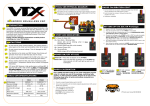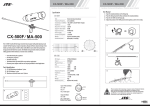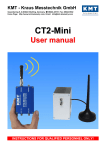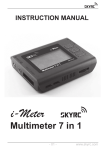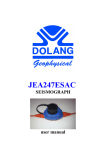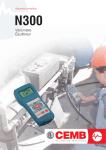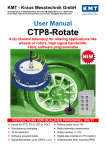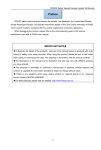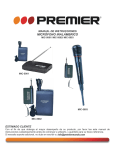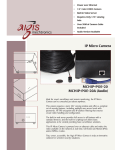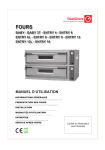Transcript
PROGRAMMING OPTION: BRAKE PROGRAMMING OPTION: DRAG BRAKE Brake Strength: Parameters from 0% (Disabled) to 100%, (1% incremental). A lower Brake Strength percentage will have less push brakes, while a higher percentage will have stronger push brakes. Brake PWM Frequency: Parameters are 2000Hz / 2500Hz / 3200Hz / 4000Hz / 8000Hz / 12000Hz / 16000Hz PWM stands for Pulse Width Modulation and is rated in Hertz, meaning cycles per second. A lower frequency will have a more aggressive braking feel. A higher frequency results in smoother braking, is more precise, and increases the ESC temperature. Brake Curve: Parameters are +EXP1 to +EXP5 / Linear / -EXP1 to -EXP5. A negative EXP Brake Curve will have a softer brake feel at the beginning of the brakes being engaged and get more aggressive as the brake are fully engaged. A linear Brake Curve will be uniform throughout the whole brake range. A positive EXP Brake Curve has strong brakes initially and then becomes softer. Brake Strength +EXP5 +EXP1 Linear -EXP1 -EXP5 Motor RPM Neutral Brake: Parameters from 0% (Disabled) to 100%, 1% Incremental. This is how much brake is applied at neutral throttle. Neutral brake is still functional regardless if Dynamic Brake is enabled or not. DYNAMIC DRAG BRAKE Dynamic Drag Brake is an advanced function under the option of Drag Brake. It offers another step of drag brake at higher RPM of your choice. It is with 3 parameters. Trigger RPM sets the motor RPM where you wish the Dynamic Drag Brake to trigger. Max Brake Strength sets the brake strength level when Dynamic Drag Brake kicks in. Dynamic Curve sets the brake curve from Max Brake Strength to Neutral Brake point. Max Brake Strength: Parameters from 0% (Disabled) to 100%, (1% incremental). This is how much brake is applied at the top of the Dynamic Brake Curve, after the Activate RPM is reached. Dynamic Curve: Parameters are +EXP1 to +EXP5 / Linear / -EXP1 to 1EXP5. This is engaged after the Neutral Brake percentage is reached. A negative EXP Dynamic Brake Curve will have a softer brake feel at the beginning of the brakes being engaged and get more aggressive as they are fully engaged. A linear Dynamic Brake Curve will be uniform throughout the whole brake range. A positive EXP Dynamic Brake Curve has strong brakes initially and then becomes softer. Trigger RPM: Parameters from 500RPM to 60000RPM, (500RPM incremental). The motor RPM that engages the Max Brake Strength. Brake Max Brake Strength PROGRAMMING OPTION: THROTTLE Throttle PWM Frequency: +EXP5 Parameters are 2000Hz / 2500Hz / 3200Hz / 4000Hz / 8000Hz / 12000Hz / 16000Hz PWM stands for Pulse Width Modulation and is rated in Hertz, meaning cycles per second. A lower frequency will have a more aggressive throttle feel and have less motor RPM. A higher frequency results in smoother throttle, is more precise, produces more motor RPM, and increases the ESC temperature. Throttle Punch: Parameters from 1% to 100%, (1% incremental). A lower Throttle Punch percentage will have a slower throttle response and feel softer initially. A higher Throttle Punch percentage will have a faster throttle response. Throttle Curve: Parameters are +EXP1 to +EXP5 / Linear / -EXP1 to -EXP5. A lower Throttle Curve EXP will have a softer throttle feel at the beginning of the throttle power band and get more aggressive as it is fully engaged. A linear Throttle Curve will be uniform throughout the whole throttle range. A higher Throttle Curve EXP has strong throttle initially and then becomes softer. Dead Band: Parameters are Off/Narrow/Middle/Wide. This is the amount of “play” when the throttle is engaged. Off makes the throttle engage more instantaneously, while Wide would have a lag. +EXP1 Linear -EXP1 -EXP5 Neutral Brake Linear -EXP1 -EXP5 Throttle Position Start RPM: Parameters from 500 to 30000 RPM (500 RPM incremental). This sets the start RPM that acceleration timing engages. This parameter should be based on the motor KV and the track condition. To calculate Start RPM: Start RPM = Motor KV x 6.4 x 0.3 For example, if the motor KV is 2000, it will be 2000x6.4x0.3 = 3840. Then you set the START RPM = 3500 to 4000 Set Up Tips: Lower start RPM does not mean to have more power at lower end. The motor needs to have enough RPM before the acceleration timing could kick in efficiently. Try to start the parameter at higher side and monitor the motor temperature before making next adjustment. Finish RPM: Parameters from 500 to 50000 RPM (500 RPM incremental). This sets the start RPM that acceleration timing finishes. To calculate the Finish RPM: FINISH RPM = Motor KV x 6.4 For example, if the motor KV is 2000, it will be 2000x6.4 = 12800. Then you set the finish RPM = 12000 to 13000 Max Advanced Timing: Parameters from 0 to 40 degrees (1 degree incremental). This sets the maximum advanced timing at the time the motor reaches the set Finish RPM. TOP SPEED TIMING Slew Rate: Parameters from 1 to 50 degrees/1000RPM (1 degree incremental). This sets how fast the ESC reaches the maximum advanced top speed timing. The larger number will have more aggressive top speed acceleration while the smaller number will have smoother feel. Max Advanced Timing: Parameters from 0 to 40 degrees. This sets the maximum advanced timing at the time the motor reaches top speed range. PROGRAMING OPTION: MISC CONTROL Run Mode: PROGRAMING OPTION: PROTECTION Battery Cut Off: Parameters from 4.5V to 13.5V, 0.1V Incremental. Allows user to set the cut-off for the appropriate voltage per type of battery used. ESC Temperature Cut Off: +EXP1 ACCELERATION BOOST RPM Parameters from 160 Degrees to 270 Degrees (10 degrees incremental). Motor temperature cut activation is indicated by blinking “F” and “R” LEDs. +EXP5 VIPER VTX series ESC offers advanced timing system for extreme racing competitions. The MOTOR POWER has 2 sections with 5 parameters. It allows you to set up and enhance acceleration and top speed performance. Tips: Always start testing the MOTOR TIMING with minimum advanced timing. Most sensored brushless motors have 30 degrees physical advanced timing with adjustable end bell for more or less timing. The total advanced timing (motor + ESC) should not be over 60 degrees for optimized performance and efficiency. Warning: MOTOR TIMING option generates a lot of power and will easily overheat and moreover to damage both ESC and motor. VIPER R/C SOLUTIONS will not be responsible for any equipment damage caused by MOTOR POWER settings. Trigger RPM Motor Temperature Cut Off: Throttle Punch PROGRAMMING OPTION: MOTOR POWER Parameters from 160 Degrees to 270 Degrees (10 degrees incremental). ESC temperature cut activation is indicated by blinking “F” and “R” LEDs with solid “N” LED. Parameters are Practice/Race Stock/Race Modified. Practice allows all settings to be adjusted on the ESC. Also, it allows reverse. Race Stock locks out reverse and does not allow any Motor Timing to be adjusted. Race Modified locks out reverse while maintaining Motor Timing adjustability. SBEC Voltage: Parameters from 5.0V to 7.0V (0.1V incremental). A higher voltage will make servos react faster at the expense of a shorter life span. However, do not set SBEC Voltage above the servo manufacturer’s recommended voltage. Forward Power: Parameters from 50% to 100%(1% incremental). This setting allows you to limit the forward power. Reverse Power: Parameters from 25% to 100%(1% incremental). This setting allows you to limit the reverse power. Auto Power Off: Parameters from 1 to 10 minutes(1 minute incremental). This allows the user to set the ESC to power off if it remains in neutral for the amount of minutes set.
